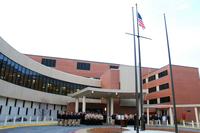The Army’s 3rd Brigade of the 10th Mountain Division will arrive next month in Afghanistan, the vanguard of an anticipated 20,000 troop plus-up in the country over the next year. The new troops will be arriving none too soon.
In a sign of how grim the situation is, the brigade is not being sent down south to reinforce coalition troops in embattled Kandahar and Helmand provinces, scene of the heaviest fighting over the past two years, nor is it being sent to the eastern border, where a remote American outpost at Wanat was nearly overrun by a Taliban attack in July.
Instead, the bulk of the brigade will deploy directly south and west of Kabul, to safeguard the capital, according to a New York Times report over the weeekend.
It’s a stunning acknowledgement of the growing Taliban strength and the threat they pose to the vital ring road, the only real highway, that connects Kabul to the embattled south. Roadside bomb attacks and ambushes on the southern stretches of Highway 1 have jumped in recent months. A fuel convoy was shot-up there last summer, some of the drivers were dragged out and beheaded. A patrol of New York and Michigan National Guard soldiers was ambushed in the area during the summer. The bodies were reportedly dismembered and had organs removed.
A new report from Kabul based researchers from France’s International Council on Security and Development, formerly the Senlis Council, says the Taliban “are closing a noose around the city and establishing bases close to the city from which to launch attacks inside it.” While Senlis council reports tend to be a bit hyperbolic, the report correctly identifies the threat the Taliban now pose to lines-of-communication in Afghanistan. It highlights Logar and Wardak provinces as being particularly dangerous and says the Taliban has a "permanent presence" in 72 percent of the country (although the notion of permanent presence in a guerrilla war is rather tough to define).
I was embedded with an American unit operating near Logar in 2006, when it was considered one of the quietest sectors in the country; it was considered an “economy-of-force” area. That’s clearly not the case anymore as the insurgency pushes further north. While the Taliban don’t directly threaten Kabul, at least not yet, and there remains a pretty sizeable ISAF force in the city, its reasonable to expect high profile attacks, such as ambushes along the airport road or the road north to the massive American base at Bagram, either of which would be public relations disasters for the Karzai government and the coalition.
In other news, Taliban insurgents in Pakistan torched over 100 trucks carrying supplies to coalition forces in Afghanistan. This is the third big attack in the past month on the vital lifeline that carries 80 percent of supplies bound for troops in Afghanistan. Not all of the attacks are by insurgents, some are by criminal gangs preying on the bounty of unprotected convoys. This time insurgents hit trucking terminals near Peshawar, where a car bomb detonated in the center of the city last week killing 29 people.
The AP version of the attack quoted a former Pakistani tribal security official who says that in recent months insurgents have moved into the Khyber pass region, on both sides of the border. The pass is deep inside tribal territory and has long been considered under tacit Taliban control. In early November the Taliban hijacked a convoy of trucks. It would appear they have tired with just taxing the convoys and now are choosing to destroy or make off with the loads.
If the Taliban can easily cut transit across the Khyber pass, the U.S. will be forced to shift some of the arriving brigade to the area to keep the vital supply line open. U.S. military officials have said that they are trying to find an alternate ground supply route through Central Asia. If you thought the drive from Karachi across the length of Pakistan to Bagram was a long one, try to calculate out how long a drive it is from Black Sea ports through the various former Soviet–stans to Afghanistan.
The ICOS report says the Taliban are maneuvering to fill the governance void at the local level, and have done so successfully in some parts of the country. One key to their acceptance among the local population today versus seven years ago, is that they are “offering a mellower version of localized leadership than characterized their last stint in power.” The report also says the line between insurgent and criminal activity is blurring across much of the country where lawlessness is the norm. Kidnappings for ransom have certainly escalated of late.
Attacking supply lines and convoys is a fairly typical “cost-imposition” strategy on the part of the insurgents. Recall that during the Soviet-Afghan war the mujahideen focused their attacks on Soviet lines-of-communication. But the attacks on the ring road and across the border on the transit sites in Pakistan imply that there is a central direction or coordination at work, and that the Taliban may be following a specific strategy, rather than just random attacks across the country.







